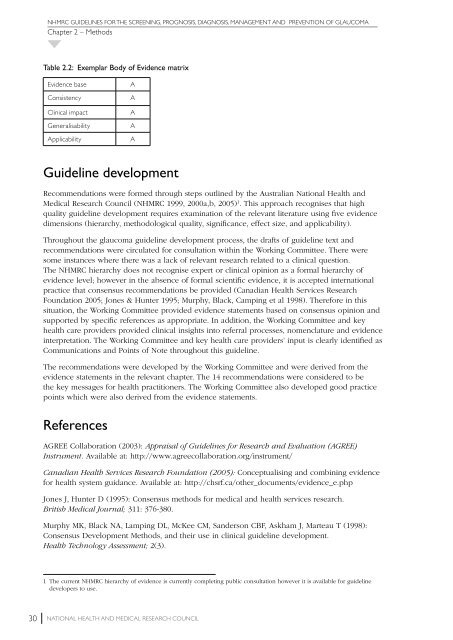NHMRC Glaucoma Guidelines - ANZGIG
NHMRC Glaucoma Guidelines - ANZGIG
NHMRC Glaucoma Guidelines - ANZGIG
You also want an ePaper? Increase the reach of your titles
YUMPU automatically turns print PDFs into web optimized ePapers that Google loves.
<strong>NHMRC</strong> GUIDELINES FOR THE SCREENING, PROGNOSIS, DIAGNOSIS, MANAGEMENT AND PREVENTION OF GLAUCOMA<br />
Chapter 2 – Methods<br />
Table 2.2: Exemplar Body of Evidence matrix<br />
Evidence base<br />
Consistency<br />
Clinical impact<br />
Generalisability<br />
Applicability<br />
A<br />
A<br />
A<br />
A<br />
A<br />
Guideline development<br />
Recommendations were formed through steps outlined by the Australian National Health and<br />
Medical Research Council (<strong>NHMRC</strong> 1999, 2000a,b, 2005) 1 . This approach recognises that high<br />
quality guideline development requires examination of the relevant literature using five evidence<br />
dimensions (hierarchy, methodological quality, significance, effect size, and applicability).<br />
Throughout the glaucoma guideline development process, the drafts of guideline text and<br />
recommendations were circulated for consultation within the Working Committee. There were<br />
some instances where there was a lack of relevant research related to a clinical question.<br />
The <strong>NHMRC</strong> hierarchy does not recognise expert or clinical opinion as a formal hierarchy of<br />
evidence level; however in the absence of formal scientific evidence, it is accepted international<br />
practice that consensus recommendations be provided (Canadian Health Services Research<br />
Foundation 2005; Jones & Hunter 1995; Murphy, Black, Camping et al 1998). Therefore in this<br />
situation, the Working Committee provided evidence statements based on consensus opinion and<br />
supported by specific references as appropriate. In addition, the Working Committee and key<br />
health care providers provided clinical insights into referral processes, nomenclature and evidence<br />
interpretation. The Working Committee and key health care providers’ input is clearly identified as<br />
Communications and Points of Note throughout this guideline.<br />
The recommendations were developed by the Working Committee and were derived from the<br />
evidence statements in the relevant chapter. The 14 recommendations were considered to be<br />
the key messages for health practitioners. The Working Committee also developed good practice<br />
points which were also derived from the evidence statements.<br />
References<br />
AGREE Collaboration (2003): Appraisal of <strong>Guidelines</strong> for Research and Evaluation (AGREE)<br />
Instrument. Available at: http://www.agreecollaboration.org/instrument/<br />
Canadian Health Services Research Foundation (2005): Conceptualising and combining evidence<br />
for health system guidance. Available at: http://chsrf.ca/other_documents/evidence_e.php<br />
Jones J, Hunter D (1995): Consensus methods for medical and health services research.<br />
British Medical Journal; 311: 376-380.<br />
Murphy MK, Black NA, Lamping DL, McKee CM, Sanderson CBF, Askham J, Marteau T (1998):<br />
Consensus Development Methods, and their use in clinical guideline development.<br />
Health Technology Assessment; 2(3).<br />
1 The current <strong>NHMRC</strong> hierarchy of evidence is currently completing public consultation however it is available for guideline<br />
developers to use.<br />
30 National Health and Medical Research Council





